Understanding Adolescent Relationships: Key Insights
Personal Relationships
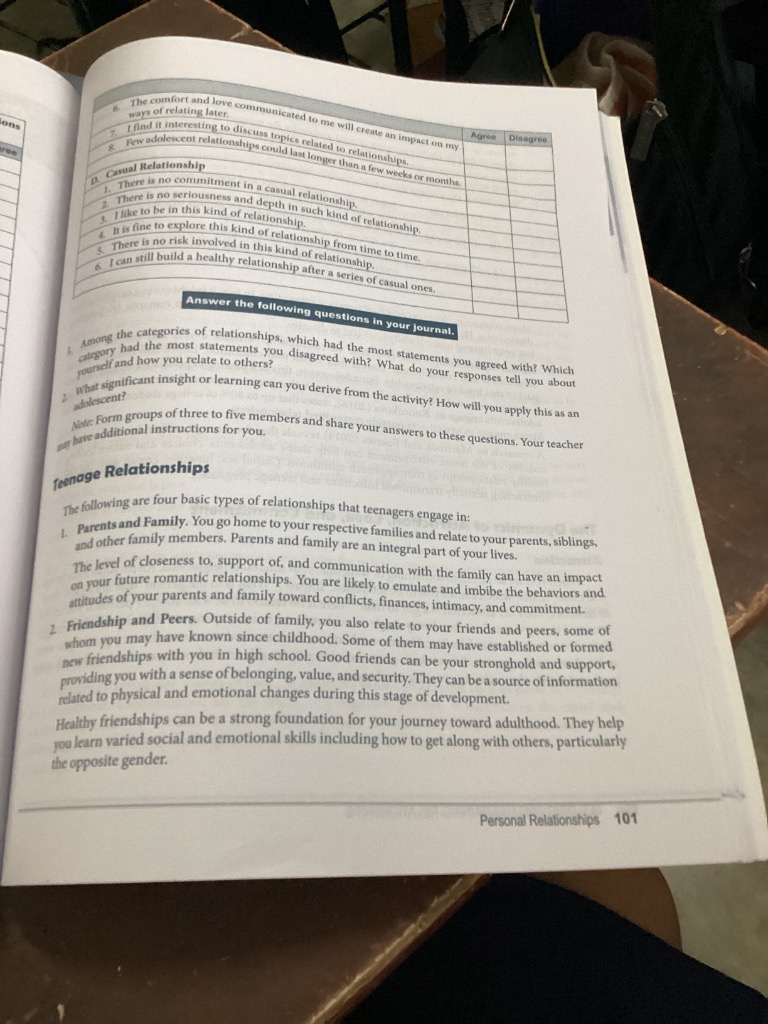
Types of Relationships
- Teenage Relationships
- Parents and Family: Importance of family connections in shaping future relationships. Relationships with parents can influence communication styles and conflict resolution.
- Friendship and Peers: Highlights the role of friendships formed during high school. Good friends provide emotional support and contribute to personal development.
Casual Relationships Table
| Statement | Agree | Disagree |
|---|---|---|
| 1. There is no commitment in a casual relationship. | ||
| 2. There is no seriousness and depth in such a relationship. | ||
| 3. I like to be in this kind of relationship. | ||
| 4. It is fine to explore this kind of relationship from time to time. | ||
| 5. There is no risk involved in this kind of relationship. | ||
| 6. I can still build a healthy relationship after a series of casual ones. |
Thoughts on Casual Relationships
- Lack of Commitment: Casual relationships are appealing to those who prioritize fun and exploration over deep emotional connections.
- Depth and Seriousness: Understanding that these relationships may lack emotional depth is crucial in managing expectations.
- Exploration: Engaging in casual relationships can be a way to learn about personal desires and preferences in dating.
- Risk Awareness: It's important to recognize potential emotional risks, as even casual relationships can impact mental well-being.
- Healthy Transition: One can transition from casual relationships to more serious ones, provided boundaries and communication are maintained.
Extended readings:
Notes on Romantic Relationships and Attraction
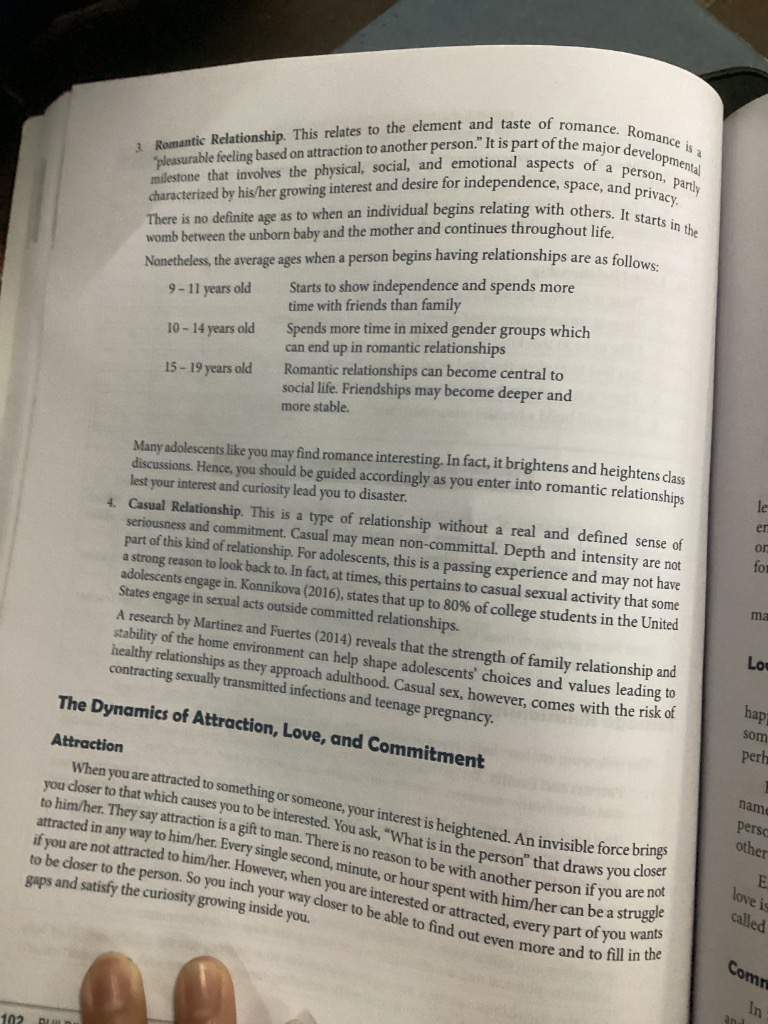
Romantic Relationships
- Definition: A romantic relationship is characterized by emotional and physical attraction between individuals. It is a crucial part of human development and involves several aspects of interaction.
- Developmental Milestones:
- 9–11 years old: Children start to show independence and prefer spending time with friends rather than family.
- Thoughts: This age marks the beginning of forming relationships outside the family unit, which is essential for social development.
- 10–14 years old: Adolescents spend more time in mixed-gender groups, leading to the possibility of romantic relationships.
- Thoughts: This is a significant period for identity formation and understanding sexual attraction and relationships in a social context.
- 15–19 years old: Romantic relationships often take center stage in social life, and friendships may deepen or transform.
- Thoughts: At this stage, peer influence becomes particularly strong, impacting personal development and relationship dynamics.
- 9–11 years old: Children start to show independence and prefer spending time with friends rather than family.
Casual Relationships
- Description: Casual relationships lack the seriousness and commitment of more traditional romantic partnerships. They can be non-committal and often do not involve deep emotional connections.
- Thoughts: Understanding the nature of casual relationships is important to navigate potential emotional risks, especially in adolescence.
- Associated Risks: Engaging in casual sex can lead to health risks such as sexually transmitted infections (STIs) and unintended pregnancies. Awareness and education are essential for safe practices.
Attraction
- Mechanism of Attraction: When attracted to someone, individuals experience heightened interest, driven by an invisible force that draws them closer.
- Thoughts: This attraction can lead to emotional highs but may also come with anxiety about how to connect with the other person meaningfully.
- Importance of Awareness: Realizing one’s attractions can inform relationship choices and help individuals understand their desires.
- Insights: Every interaction can lead to a deeper understanding of what one seeks in relationships, thus fostering personal growth.
This summary discusses the dynamics of romantic relationships, focusing on developmental milestones, the nature of casual relationships, and the mechanics of attraction. Understanding these concepts can aid in better interpersonal skills and emotional intelligence as one navigates relationships through different life stages.
Extended readings:
Notes on Attraction, Love, and Commitment

Attraction
- Definition: Attraction refers to the act of attracting and evoking interest, pleasure, or liking for someone.
- Thoughts: Understanding attraction is crucial in relationships as it initiates romantic feelings. It's often influenced by shared interests and desires.
Forms of Attraction
-
Crush:
- An adolescent may desire to emulate another person’s admired qualities, leading to a romantic or infatuated connection.
- Ideas: Crushes can be fleeting and often reflect idealization rather than deep emotional connections.
-
Courtship:
- Involves stages where individuals date to get to know each other intimately.
- Explanation: Realizing that some might prefer remaining friends rather than moving deeper into dating highlights the variability in relationship paths.
-
Going Steady:
- Represents a stage where two individuals commit to deepening their relationships with greater exclusivity.
- Additional Information: This can be an important step that often leads to longer-term commitments or engagement.
Love
- Definition: Being in love often reflects feelings of happiness and euphoria, but it encompasses deeper emotional connections.
- Thoughts: Love is multifaceted, including emotional support and mutual care, which greatly enriches relationships.
Components of Love
-
Attachment:
- Desire for the presence of the other person, focusing on emotional connection and support.
- Ideas: Healthy attachment can foster a secure emotional base for any relationship.
-
Caring:
- Involves concern for the partner's well-being, which reinforces the relationship bond.
- Explanation: Acts of kindness and consideration solidify partnerships and build trust.
-
Intimacy:
- Encompasses privacy, closeness, and communication between partners.
- Thoughts: Building intimacy requires vulnerability and understanding, essential for deep connections.
Commitment
- Definition: Commitment, as defined by Sternberg's Triangular Theory of Love, plays a critical role in sustaining relationships.
- Thoughts: Commitment can be viewed as a conscious choice, influencing the success and longevity of partnerships.
Components of Commitment
-
Passion:
- Refers to the physical attraction and romantic feelings, often driving initial attraction.
- Ideas: Passion can fluctuate over time but is crucial in keeping relationships vibrant.
-
Intimacy:
- Involves the emotional closeness and connection individuals feel toward each other.
- Explanation: Supportive intimacy can enhance the quality of relationships and counteract challenges.
-
Decision/Choice:
- Represents the conscious decision to stay with a partner despite challenges.
- Thoughts: This aspect of commitment highlights the rational side of relationships, emphasizing the importance of dedication.
Summary
Understanding attraction, love, and commitment provides a comprehensive view of the dynamics in personal relationships. Healthy relationships require not only attraction but also love grounded in emotional support and a commitment that endures through challenges.
Extended readings:
Adolescent Expression of Attraction, Love, and Commitment
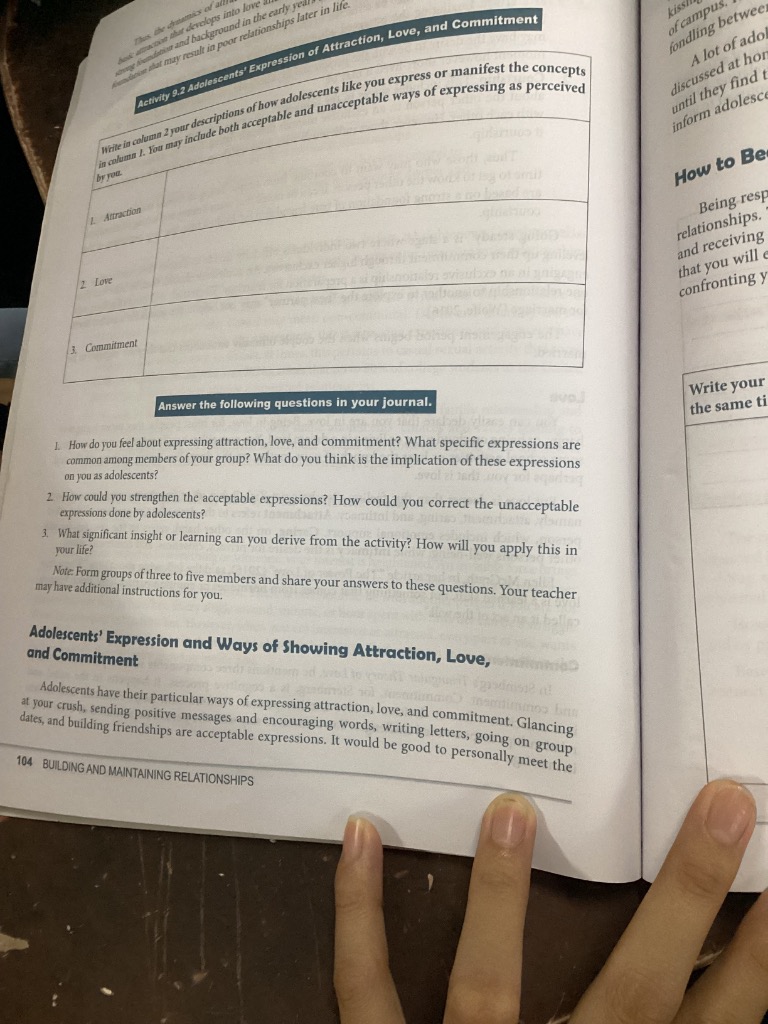
Key Concepts
- Attraction: This refers to the initial feelings or interest one develops towards another person, often influenced by physical appearance, personality, or social dynamics.
- Thought: Understanding attraction during adolescence is crucial, as it shapes social experiences and relationships.
- Love: A deeper, more emotional connection that evolves over time and often includes affection, care, and intimacy.
- Thought: Adolescents may express love in diverse ways, and recognizing these methods can inform how supportive interactions shape their relationships.
- Commitment: The intention to maintain a relationship over time, indicating a level of responsibility and devotion.
- Thought: Exploring how commitment is expressed can highlight maturity and understanding in relationships among adolescents.
Table of Acceptable and Unacceptable Ways to Express Attraction, Love, and Commitment
| Category | Acceptable Ways | Unacceptable Ways |
|---|---|---|
| Attraction | Glancing at a crush, sending messages | Stalking or invasive behaviors |
| Love | Writing letters, sharing feelings | Manipulating emotions, dishonesty |
| Commitment | Going on group dates, building friendships | Neglecting responsibilities, coercion |
Discussion Questions
-
Feelings about expressing attraction, love, and commitment:
- It's important to consider how openly discussing these feelings among peers can foster better understanding and help normalize various expressions of affection.
-
Specific group expressions and implications:
- Observing specific expressions common within a peer group can provide insight into social norms and what is considered acceptable behavior in their context.
-
Correcting unacceptable expressions:
- Discussing unacceptable expressions is vital for developing healthy relationship boundaries and ensuring mutual respect among peers.
-
Insights from the activity:
- Engaging in this reflection can lead to greater self-awareness and improved interpersonal relationships by recognizing one's own feelings and behaviors, as well as those of others.
Summary
The activity encourages adolescents to explore and critically assess how they express attraction, love, and commitment. By discussing both acceptable and unacceptable behaviors, adolescents can gain insights into their emotions and relationships, leading to healthier social interactions as they mature.
Extended readings:
Notes on Managing Relationships and Responsibility
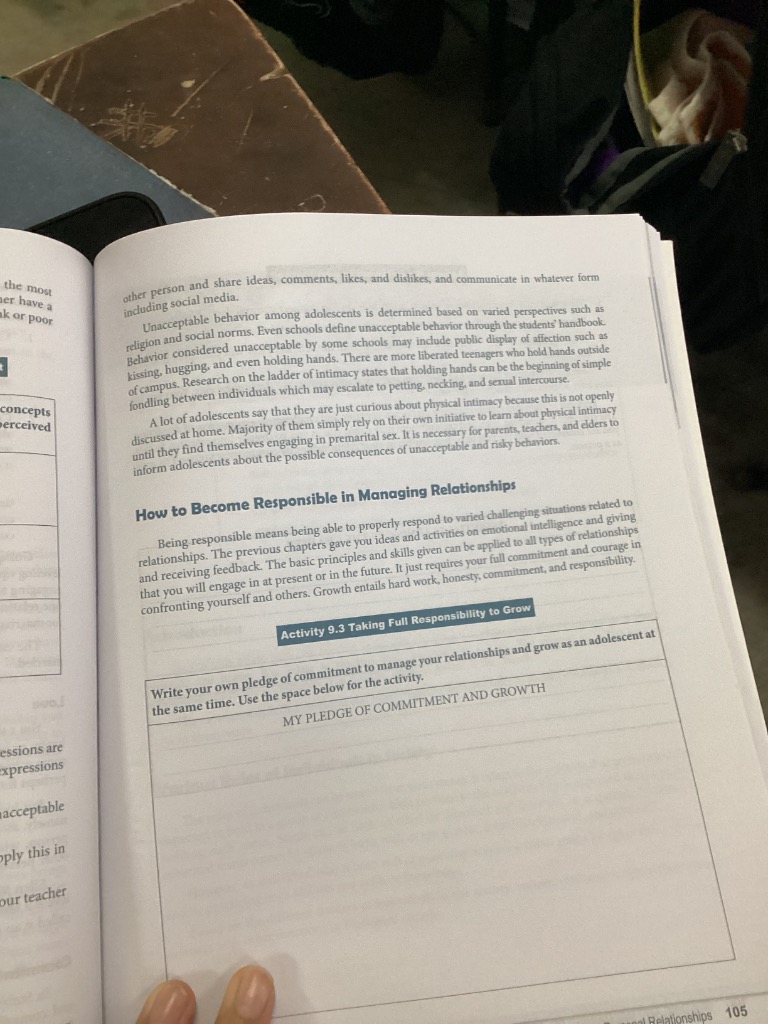
Unacceptable Behavior Among Adolescents
- Summary: This section discusses how unacceptable behavior, particularly among adolescents, is influenced by schools, social norms, and individual understanding.
- Thoughts: Understanding the dynamics of peer behavior is crucial in nurturing healthy relationships. Schools often set boundaries for behavior, which helps to streamline social interactions.
Physical Intimacy and Curiosity
- Summary: Adolescents often have curiosity regarding physical intimacy, which can lead to confusion about acceptable behaviors.
- Ideas: It’s important to have open conversations about boundaries and the meanings of physical gestures, which can be different across various cultural contexts.
Becoming Responsible in Relationships
- Definition: Being responsible involves responding properly to challenges in relationships and learning from feedback.
- Thoughts: Responsibility in relationships is like building blocks; each experience contributes to personal growth and emotional maturity.
Activity 9.3: Pledge of Commitment
- Purpose: This activity encourages adolescents to take personal responsibility for managing their relationships.
- Ideas: Writing a personal pledge can clarify intentions and promote accountability in relationships. It serves as a personal guide to strengthen commitment to growth.
Example Pledge
- Format: "MY PLEDGE OF COMMITMENT AND GROWTH"
- Additional Info: Creating a personal pledge can involve outlining specific actions or behaviors one aims to adopt, as well as acknowledging areas for improvement in managing relationships effectively.
Extended readings:
Social Relationships in Middle and Late Adolescence
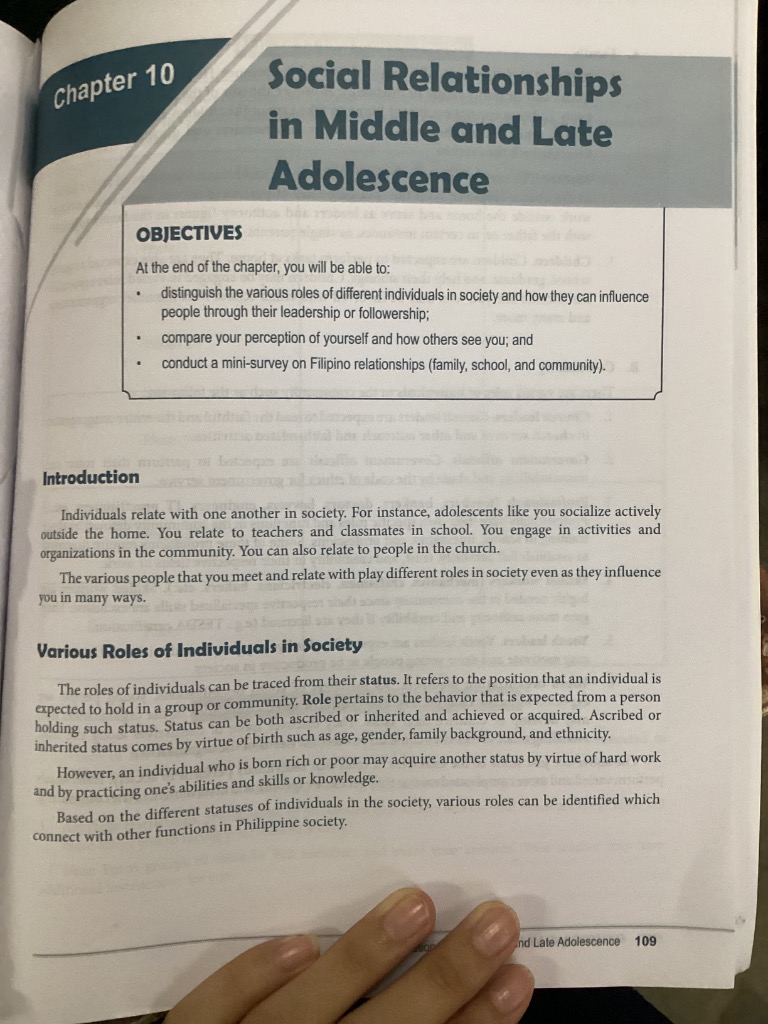
Objectives
- Distinguish Various Roles: Understanding the different roles individuals play in society during adolescence helps identify how they influence one another through leadership or followership.
- Thoughts: This is crucial for personal development and navigating social dynamics effectively.
- Compare Self and Others' Perceptions: Analyzing how one perceives themselves compared to how they are perceived by others can lead to personal insights and growth.
- Additional Information: Self-awareness during adolescence is key for establishing a positive self-identity.
- Conduct Mini-Survey: Engaging in surveys about Filipino relationships (family, school, and community) can provide practical insights into social interactions and norms.
- Ideas: This can serve as a tool for understanding cultural differences and social responsibilities within various contexts.
Introduction
- Social Interactions: Adolescents relate to several individuals in different contexts, such as family, school, and community, which contribute to their social identity.
- Thoughts: Navigating these relationships is vital in developing social skills and emotional intelligence.
- Influence of Roles: The roles individuals play can influence how they interact socially, thus shaping their experiences as adolescents.
- Additional Information: Different environments can foster distinct interactions and social learning opportunities.
Various Roles of Individuals in Society
-
Status: Roles are often associated with the status an individual holds within a group or community.
- Thoughts: Understanding one's status can influence interactions and the level of power or influence one has in social situations.
-
Role Definition:
- Ascribed Status: Involves roles associated with birth, such as family background and ethnicity. These roles are seen as part of one's identity from the start.
- Achieved Status: Involves roles earned through personal effort, skills, and knowledge.
- Ideas: This differentiation highlights the dynamic nature of social roles and the potential for change through individual effort.
-
Other Factors: An individual's social status can be influenced by economic background, education, and personal achievements.
- Additional Information: Understanding these factors can help adolescents navigate their social environments more effectively.
| Role Type | Description |
|---|---|
| Ascribed Status | Roles derived from birth (e.g., ethnicity, family) |
| Achieved Status | Roles acquired through personal effort and skills |
- Connections in Society: Based on various statuses, roles within the Filipino society can connect individuals with different aspects of community and cultural practices.
- Thoughts: Recognizing these connections can foster a sense of belonging and responsibility within community interactions.
Extended readings:
Notes on Family and Community Roles
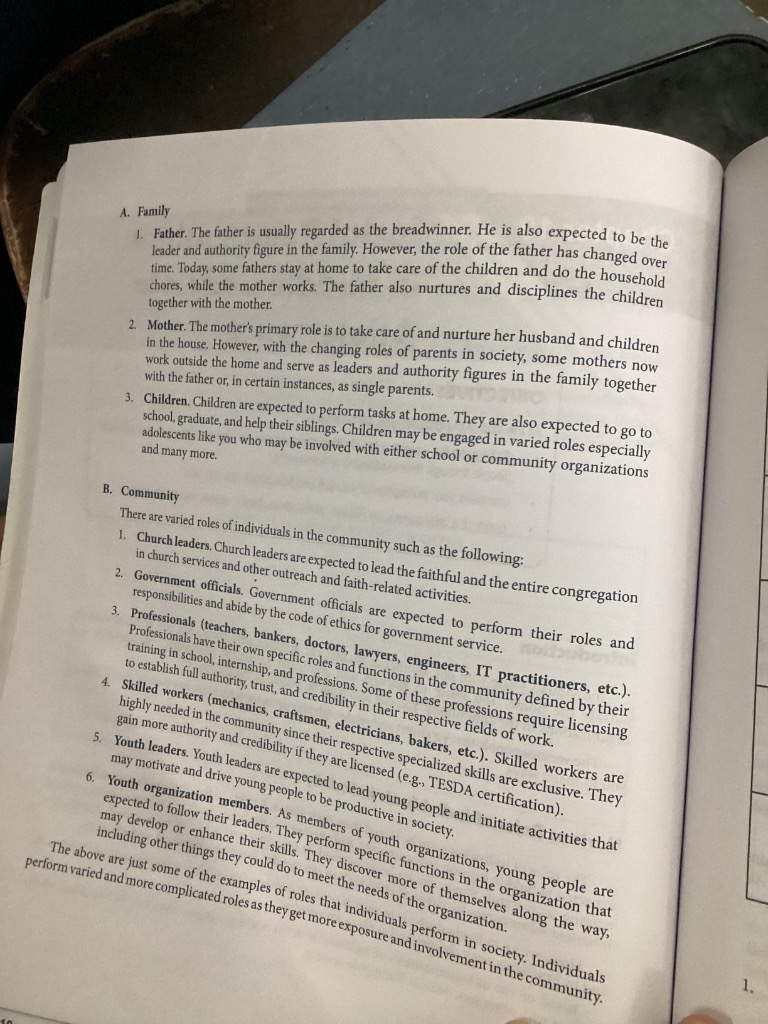
A. Family
-
Father
- The father is traditionally viewed as the breadwinner and the authority figure within the family.
- Thoughts: This role has evolved, with many fathers now taking on more domestic responsibilities.
- Additional Info: Fathers often engage in nurturing and disciplinary roles alongside their partners, indicating a shift towards shared parenting responsibilities.
-
Mother
- The mother is primarily responsible for nourishing and caring for her husband and children.
- Thoughts: As societal norms change, mothers may also work outside the home, taking on leadership roles.
- Additional Info: This role's evolution reflects the increasing participation of women in the workforce and the evolving dynamics of family structures.
-
Children
- Children are expected to assist with household tasks and responsibilities, as well as support their siblings.
- Thoughts: This involvement fosters a sense of family unity and helps children develop crucial life skills.
- Additional Info: Children can also engage in community activities, which enhances their social skills and community awareness.
B. Community
Roles within the Community
| Role | Description |
|---|---|
| Church Leaders | Expected to lead faith-based activities and the congregation during services. |
| Government Officials | Responsible for performing roles ethically and abiding by government codes. |
| Professionals | Includes teachers, bankers, doctors, and other specialists who adhere to specific codes of conduct. |
| Skilled Workers | Comprises craftsmen, electricians, bakers, etc., who possess specialized skills requiring licensing. |
| Youth Leaders | Assist in guiding young individuals, motivating and developing their skills. |
| Youth Organization Members | Engage in various activities to enhance their skills and contribute to the organization's needs. |
- Thoughts: Each community role emphasizes a contribution to the social fabric and ensures the well-being of individuals within society.
- Additional Info: The active participation of individuals in these roles can lead to improved community cohesion, shared resources, and a support system among members.
Conclusion
Understanding the roles within families and communities is essential for grasping the dynamics of societal interactions and responsibilities. Each role contributes to a nurturing environment, promoting growth both within families and the larger community.
Extended readings:
Notes on Social Roles and Influence
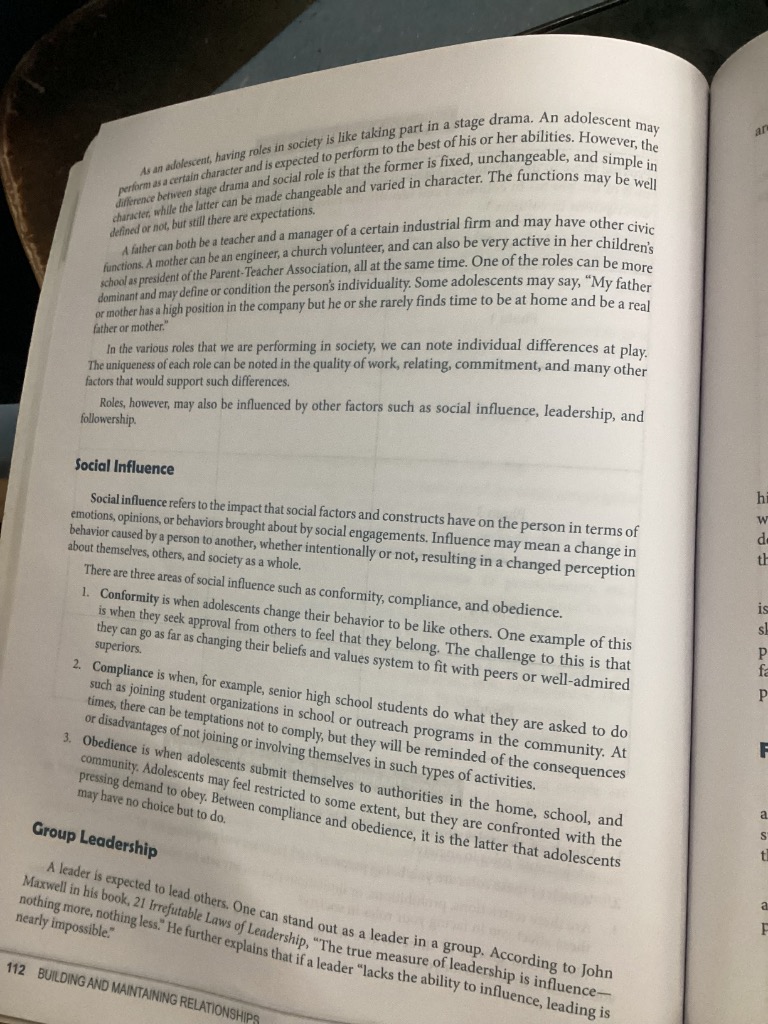
Social Roles in Society
-
Adolescent Roles:
- Adolescents are likened to actors in a stage drama, where they perform certain societal roles.
- Their roles may have expectations that are influenced by factors like family, education, and community.
- The distinction between a "character" and a "social role" is key; while a character may be static, a social role can evolve over time.
-
Example of Parental Roles:
- Parents may fulfill multiple roles, such as being a teacher or a community volunteer. These positions can conflict, reflecting the complexity of individual identities and responsibilities.
- This illustrates the need for balance between different societal roles and the impact on one's personal identity and family dynamics.
Social Influence
Key Areas of Social Influence
-
Conformity:
- Definition: Changing behavior to align with group standards.
- Implication: Adolescents may adjust their behavior to gain approval or to fit in, highlighting the pressure of peer influence.
- Challenge: Maintaining one's individuality while striving for acceptance can be difficult.
-
Compliance:
- Definition: Adhering to requests or pressures from groups, such as student organizations.
- Implication: Participation in school activities can lead to a sense of belonging, but may also evoke feelings of obligation or reluctance due to external pressures.
- Consideration: Recognizing the balance between personal choice and social expectations is essential.
-
Obedience:
- Definition: Submitting to authority figures, such as parents or teachers.
- Implication: Adolescents often face societal and familial pressures that can limit their freedom and choices.
- Reflection: Understanding when obedience is appropriate versus when it might hinder personal growth is crucial.
Group Leadership
- Role of a Leader:
- Leaders are expected to guide others and influence group dynamics positively.
- According to John Maxwell, effective leadership is rooted in the ability to influence others, emphasizing that leadership isn’t just about authority, but also about fostering connections and relationships within a group.
- Thought on Leadership:
- The effectiveness of a leader is often measured by their ability to inspire and motivate, which aligns with the principles of social influence discussed earlier.
Overall, understanding the dynamics of social roles, influence, and leadership is vital for adolescents as they navigate their developmental stage and interpersonal relationships. Building awareness of how these factors interconnect can lead to healthier interactions and stronger community ties.
Extended readings:
Leadership and Followership Notes
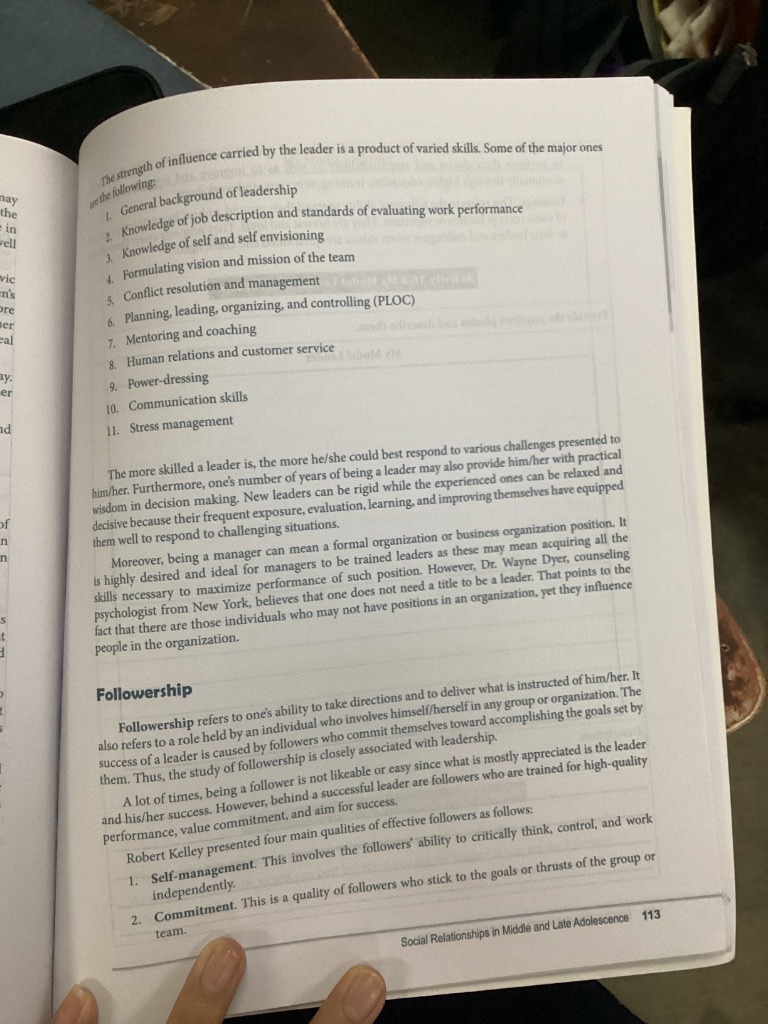
Strength of Leadership
-
General Background of Leadership
- Understanding different leadership styles is essential for effective organization. Leaders should adapt their approach based on team dynamics and situational contexts.
-
Knowledge of Job Description and Evaluation Standards
- Clearly defined roles and performance metrics help in setting expectations and measuring success. This understanding aids in accountability and productivity.
-
Knowledge of Self and Self Envisioning
- Self-awareness is crucial for leaders to recognize their strengths and weaknesses. Setting personal visions can enhance motivation and direction.
-
Formulating Vision and Mission of the Team
- A clear mission and vision unify team members and provide a common goal. This alignment fosters collaboration and commitment to objectives.
-
Conflict Resolution and Management
- Effective leaders should possess conflict resolution skills to navigate disputes and maintain harmony within the team, which is crucial for continuous progress.
-
Planning, Leading, Organizing, and Controlling (PLOC)
- PLOC is a fundamental framework for leaders to structure their approach, optimizing resource allocation and task management.
-
Mentoring and Coaching
- Leaders should invest time in mentoring their team to develop skills and encourage professional growth, fostering a positive work environment.
-
Human Relations and Customer Service
- Strong interpersonal skills and a focus on customer service are vital. Leaders must ensure that the team understands the importance of external and internal stakeholder relationships.
-
Power-Dressing
- The outward appearance of a leader can influence perceptions and establish authority. Leaders should be mindful of their professional presentation.
-
Communication Skills
- Clear, effective communication is essential for conveying ideas and instructions, enhancing team understanding and reducing misinterpretations.
-
Stress Management
- Leaders must manage their own stress and help their team cope with pressures to maintain productivity and job satisfaction.
Followership
-
Definition of Followership
- Followership plays a crucial role in leadership dynamics. A successful leader is often supported by committed followers who share a vision and goals.
-
Importance of Followership
- High-quality performance from followers is essential for executing leadership directives effectively.
Key Qualities of Effective Followers (as per Robert Kelley)
| Quality | Description |
|---|---|
| Self-management | Encourages independent thinking and responsibility among followers, promoting autonomy within the team. |
| Commitment | Followers should demonstrate dedication to the group's goals, ensuring collaborative efforts towards collective success. |
Summary
Understanding leadership involves recognizing various skills and the importance of followership. Effective leaders foster strong relationships, set clear goals, and possess strong communication and conflict resolution skills. Equally, committed followers are essential to achieving organizational objectives, contributing to a productive and harmonious work environment.
Extended readings:
Leadership and Followership Notes
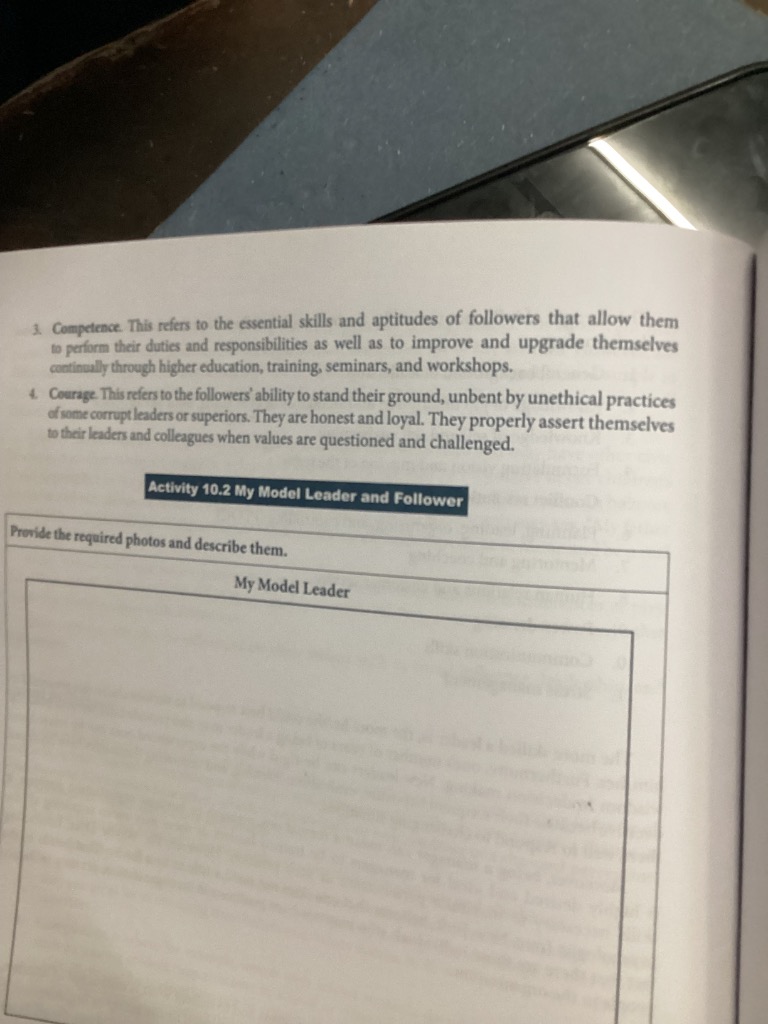
Competence
- Definition: Refers to the essential skills and aptitudes of followers that enable them to perform their responsibilities and duties effectively.
- Importance: Their continuous improvement through activities like higher education, training, seminars, and workshops is crucial for personal and organizational growth.
- Thoughts & Ideas: Competent followers contribute positively to the team's success and can take on higher responsibilities when necessary. Organizations benefit from investing in their followers' skills development as it leads to enhanced performance and loyalty.
Courage
- Definition: Describes the followers' ability to stand their ground against unethical practices by leaders or superiors.
- Characteristics: Followers exhibiting courage are noted for their honesty and loyalty. They assert themselves properly when values are questioned or challenged.
- Thoughts & Ideas: Courageous followers can foster an ethical culture within organizations. Their willingness to question and stand up for their values can lead to positive changes and accountability within the leadership structure.
Activity 10.2: My Model Leader and Follower
- Purpose: This activity encourages reflection on leadership and followership dynamics by allowing individuals to identify their model leader and describe their qualities.
- Application: It can facilitate a better understanding of the traits and behaviors that make effective leaders and followers, promoting self-awareness and growth in both roles.
| Section | Description |
|---|---|
| My Model Leader | (Space for personal notes) |
| My Model Follower | (Space for personal notes) |
Extended readings:
Family Structures and Legacies
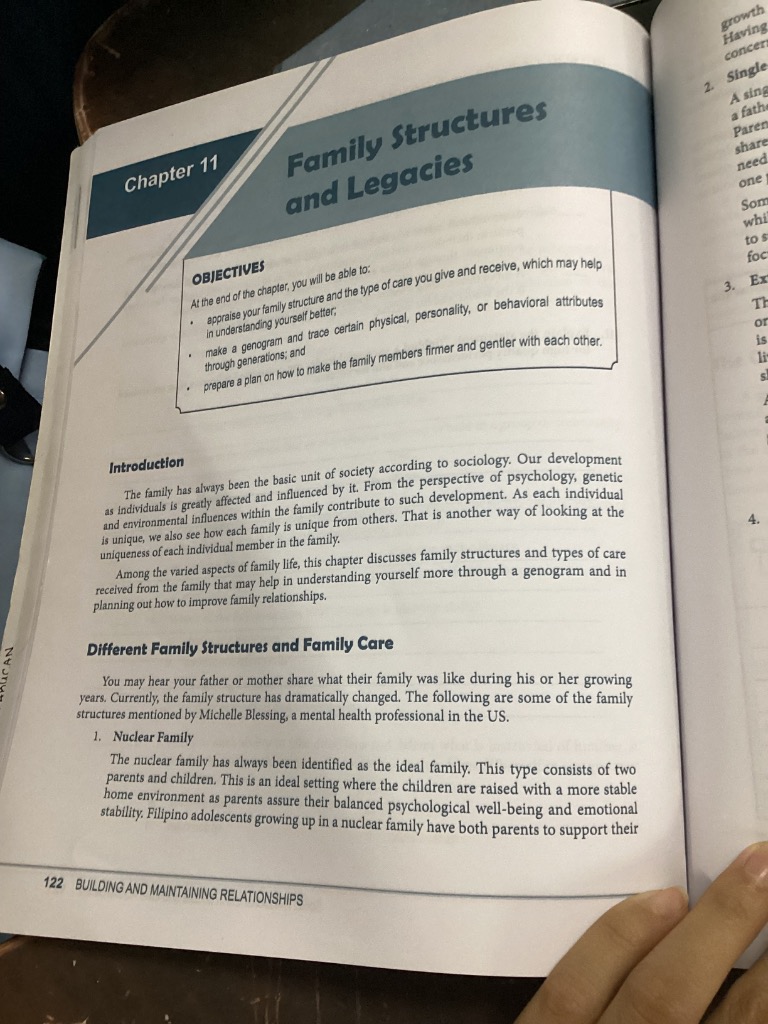
Objectives
-
Understanding Family Structure: This section emphasizes the importance of recognizing one's family structure and its influence on personal development. The concept of 'family' serves as a foundational element in sociological and psychological studies, shaping individuals' identities.
-
Genogram Creation: Creating a genogram can visually illustrate familial relationships and attributes, which is vital for improving self-understanding and relational dynamics among family members.
-
Family Interaction Improvement: The chapter suggests developing a plan to foster stronger relationships within the family, highlighting the need for intentional efforts in nurturing familial ties.
Introduction
- The role of family as a fundamental unit of society is underscored. It discusses how various psychological and environmental factors shape family dynamics.
- Each family is unique, and understanding these differences can enhance interpersonal relationships.
- The chapter aims to help individuals use their family structure to better understand themselves and improve relationships.
Different Family Structures and Family Care
1. Nuclear Family
- Definition: The nuclear family is characterized by two parents and their children, creating an optimal environment for child-rearing.
- Stability and Support: This structure is ideal because it provides emotional and psychological stability. Children in nuclear families often benefit from balanced support from both parents, which is crucial for their development.
- Cultural Context: The concept of the nuclear family may vary across cultures. In some societies, extended families may be more prevalent, but the nuclear family remains a widely accepted model for promoting well-being among children.
Additional Thoughts
-
Impact on Adolescents: Growing up in a nuclear family can greatly influence a child’s psychological well-being. It often leads to a better emotional framework as children feel more supported and secure.
-
Evolving Family Structures: It's essential to consider that family structures are evolving. As societies change, so do the definitions and dynamics of family, which includes single-parent families, blended families, and more, each bringing its own strengths and challenges.
This chapter serves as a foundational guide for understanding how different family structures impact personal development and relationships, emphasizing the importance of nurturing familial bonds for overall well-being.
Extended readings:
Family Structures and Legacies
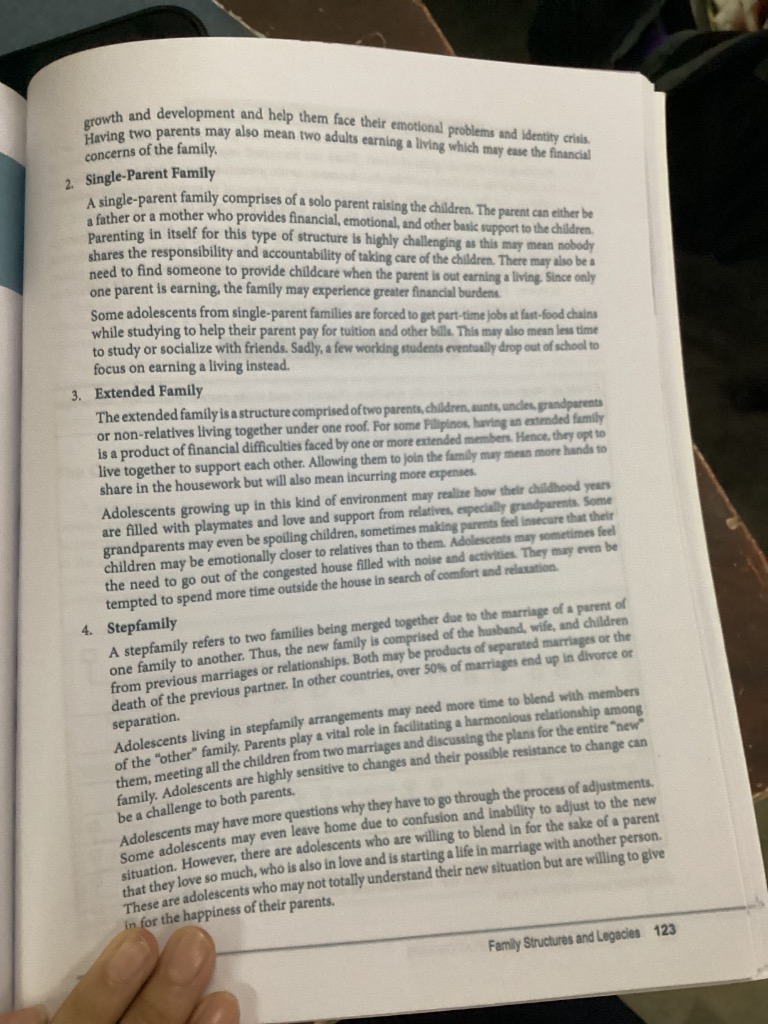
1. Single-Parent Family
- Description: A single-parent family comprises a sole parent raising children, which can be either a mother or father.
- Challenges: This structure poses significant challenges as the parent bears the sole responsibility for emotional, financial, and childcare duties.
- Considerations: Finding appropriate childcare when the parent is unavailable or earning a living is crucial. Single parents may also face financial burdens due to limited income.
- Impact on Adolescents: Adolescents from single-parent homes may need to work part-time jobs, impacting their studies and social life. This emphasizes the importance of support networks for both the parent and children.
2. Extended Family
- Description: An extended family includes not just parents and their children, but also other relatives such as grandparents, aunts, and uncles living under one roof.
- Benefits: Provides emotional support and shared responsibilities among family members, which can ease childcare challenges.
- Challenges: While filled with siblings and cousins, such environments may also lead to conflict due to differing parenting styles and space limitations.
- Role of Grandparents: Grandparents may play a significant role, although their involvement can sometimes complicate family dynamics, depending on their relationships with the parents.
3. Stepfamily
- Description: A stepfamily consists of two families merging due to the marriage of a parent to a partner with or without children.
- Adjustment Period: Children in stepfamilies may take time to adjust to new family dynamics and interpersonal relationships.
- Parent Involvement: It's essential for parents to communicate openly about family roles and encourage bonding among children from previous marriages.
- Sensitivity to Changes: Adolescents may feel particularly sensitive to changes in family structure and their new relationships with stepsiblings can be fraught with challenges.
Summary
Understanding different family structures is crucial for grasping the dynamics within families and their impact on individual growth, especially during adolescence. Each structure presents unique challenges and benefits, shaping the emotional and social experiences of children and parents alike.
Discussions around single-parent, extended, and stepfamilies should consider how these dynamics influence responsibilities, social relationships, and emotional well-being in both children and adults.
Extended readings:
Notes on Grandparent Family Structure
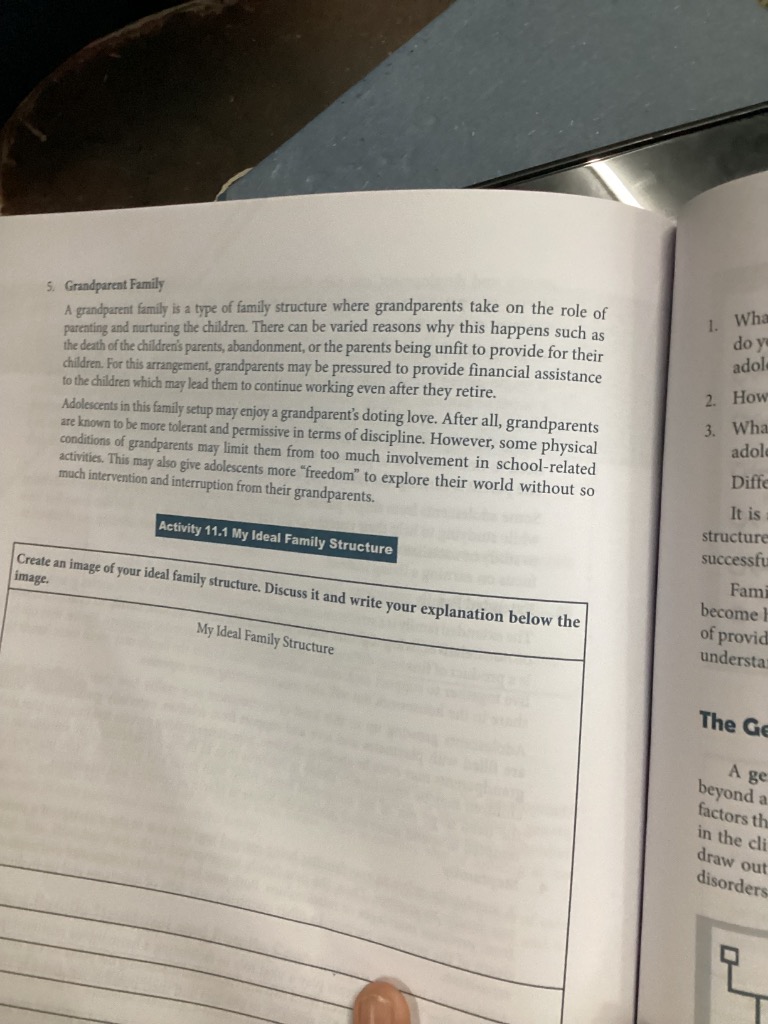
Definition of Grandparent Family
- A grandparent family is a family structure where grandparents assume the roles of parenting and nurturing their grandchildren.
- Thoughts: This shift can occur due to various circumstances, including the death of the children's parents, abandonment, or the parents being unfit to provide adequate care.
- Additional Information: The involvement of grandparents can highlight the importance of familial support networks during crises.
Reasons for Grandparent Care
- Reasons for grandparents taking on this role include:
- Death of children's parents.
- Parental unfitness due to various issues.
- Economic pressures requiring financial assistance from grandparents.
- Thoughts: Many grandparents may feel obligated to step in to ensure the well-being of their grandchildren.
- Additional Information: This arrangement can lead to complex family dynamics, where roles and responsibilities are shifted.
Characteristics of Adolescents in Grandparent Families
- Grandparents may be more tolerant and permissive in terms of discipline compared to parents.
- Thoughts: This tolerance can balance traditional discipline with a nurturing environment.
- Additional Information: Adolescents might experience affection in a less structured setting, promoting emotional bonds.
Involvement in Activities
- Physical conditions or limitations may restrict grandparents from engaging in school-related activities with grandchildren.
- Thoughts: While this could be seen as a drawback, it can also provide adolescents with the opportunity to create independence and explore their world.
- Additional Information: This balance between freedom and guidance is crucial for healthy adolescent development.
Activity: My Ideal Family Structure
- The document prompts individuals to create an image of their ideal family structure and discuss it.
- Thoughts: This exercise encourages reflection on personal values, desires for family dynamics, and the importance of relationships.
- Additional Information: Understanding one's ideal family can help in recognizing the significance of different family roles and enhancing personal relationships.
Extended readings:
Family Structures and Genograms
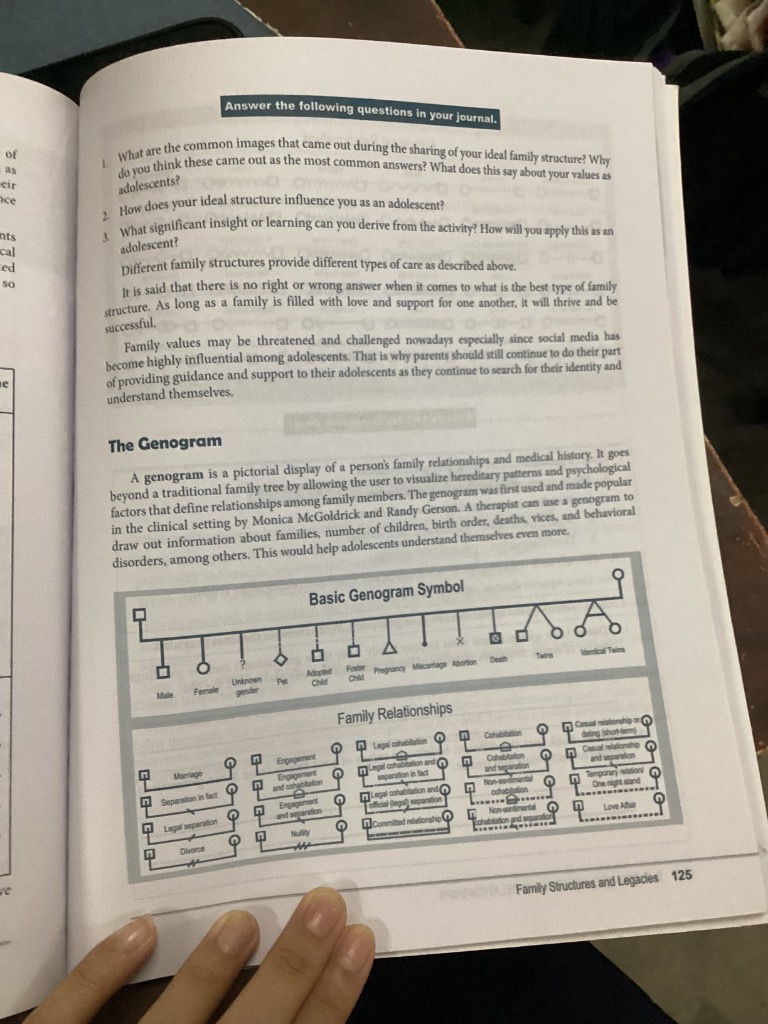
Ideal Family Structure
- Common Images: Reflects personal values and societal views on family.
- Thoughts: Discussing and sharing these images can reveal significant insights about relationships and support systems that adolescents value.
- Additional Info: The concept of the ideal family structure varies greatly by culture and individual experience, pointing to the diversity of perspectives on family roles and responsibilities.
Influence as an Adolescent
- Understanding Influence: The ideal family structure can shape identity during adolescence.
- Thoughts: Adolescents may emulate qualities from their perceived ideal family in their own relationships, impacting their self-esteem and social interactions.
- Additional Info: This phase is critical for establishing independence and values, often reflecting back to family dynamics.
Insight from Activities
- Learning Outcomes: Engaging in activities to explore family structures can lead to self-discovery.
- Thoughts: Such activities might encourage adolescents to appreciate their backgrounds and the importance of their support systems.
- Additional Info: Understanding one’s family context aids in navigating challenges during adolescent development.
Genograms
- Definition: A genogram visually represents family relationships and medical history.
- Purpose: It provides insight into family dynamics and psychological effects related to family structures.
- Thoughts: Utilizing genograms in therapy or education can enhance awareness among adolescents about their familial patterns and triggers.
- Additional Info: This tool helps identify trends that may affect behavior in future relationships and personal health.
Genogram Symbols
| Symbol Type | Symbol |
|---|---|
| Male | ♂ |
| Female | ♀ |
| Unknown Gender | ? |
| Adopted Child | [Adoption] |
| Pet | [Pet] |
| Miscarriage | [Miscarriage] |
| Abortion | [Abortion] |
| Death | [Death] |
| Twins | [Twins] |
| Identical Twins | [Ident Twins] |
Family Relationships
| Relationship Type | Symbol |
|---|---|
| Marriage | [Marriage Symbol] |
| Engagement | [Engagement Symbol] |
| Separation in fact | [Separation Symbol] |
| Legal separation | [Legal Separation] |
| Divorce | [Divorce Symbol] |
| Cohabitation | [Cohabitation Symbol] |
| Casual relationship | [Casual Symbol] |
| Committed relationship | [Committed Symbol] |
| Null | [Null Symbol] |
These symbols and definitions help in constructing a clear and evidential view of family dynamics and relationships within the genogram framework.
Extended readings:
Notes on Emotional Relationships and Genogram Chart
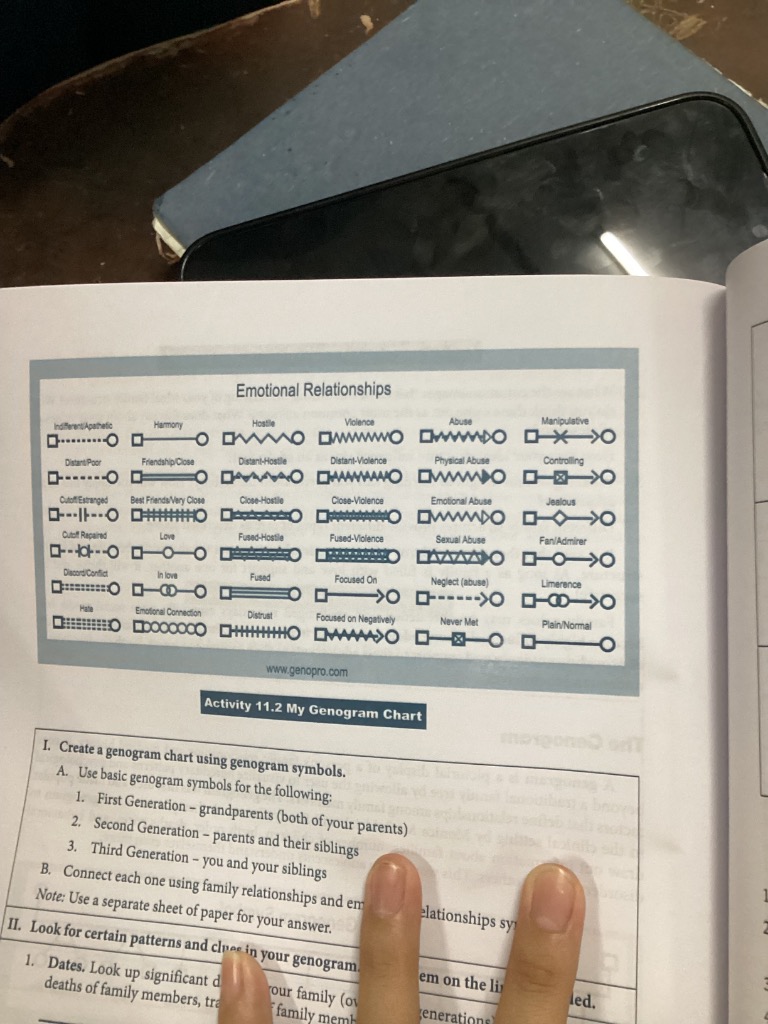
Understanding Emotional Relationships
- Emotional Relationships: The diagram categorizes emotional connections between individuals, providing symbols that illustrate the nature of these relationships. This can help in understanding family dynamics and interpersonal connections.
Table of Emotional Relationship Symbols
| Symbol | Meaning |
|---|---|
| Indifferent/Apathetic | Lack of emotional connection |
| Harmony | Positive emotional bond |
| Distant/Poor | Weak relationship |
| Friendship/Close | Strong friendship |
| Very Close | Deep emotional intimacy |
| Distant-Hostile | Tension in the relationship |
| Close-Hostile | Intimacy mixed with conflict |
| Violence | Presence of aggression |
| Distant-Violence | Aggression from a distance |
| Physical Abuse | Harmful physical interactions |
| Emotional Abuse | Psychological harm |
| Neglect (abuse) | Lack of support and care |
| Manipulative | Control in the relationship |
| Jealous | Envy affecting relationships |
| Limerence | Strong romantic infatuation |
| Focused on Negatively | Relationships characterized by negativity |
Importance of Genograms
- Genograms: Used to visually represent family relationships and dynamics over generations. This is crucial for understanding the influences of family history on current emotional relationships.
Steps to Create a Genogram
- First Generation: Document grandparents (both parents).
- Second Generation: Include parents and their siblings.
- Third Generation: Represent you and your siblings.
Practical Application
- Genograms can provide insights into patterns within family systems, revealing cycles of behavior or emotional difficulties that may persist across generations. This can be a valuable tool in therapeutic contexts or personal reflection, guiding individuals toward healthier relationships by understanding their family background.
Discussion Prompts
- Reflect on how emotional relationships in your family influence your current relationships.
- Consider how understanding your family dynamics through a genogram could help in addressing any emotional challenges.
Conclusion
Using the knowledge of emotional relationships and genograms can empower individuals to recognize patterns and make informed choices about their emotional connections, leading to healthier interactions both within the family and beyond.
Extended readings: